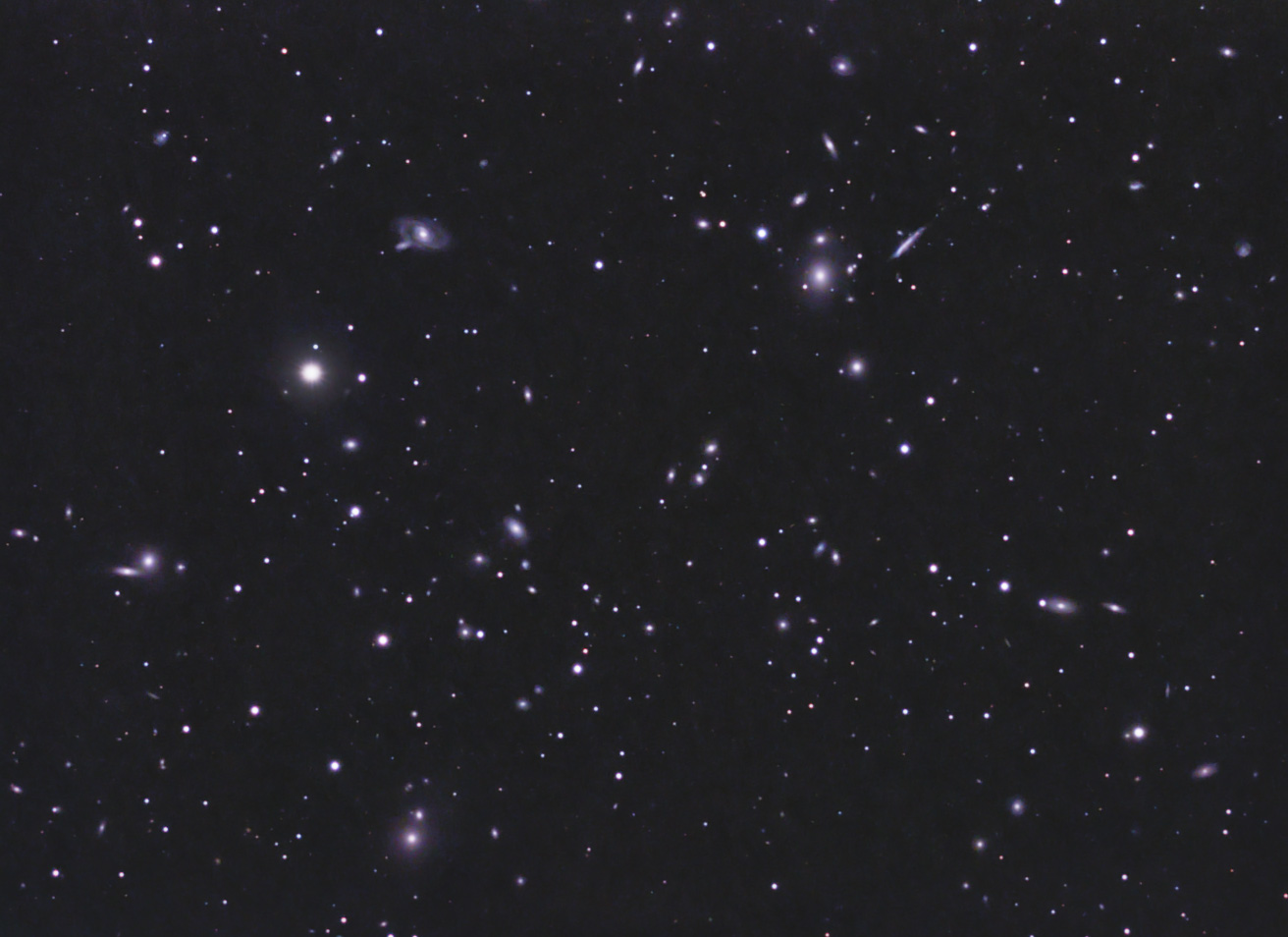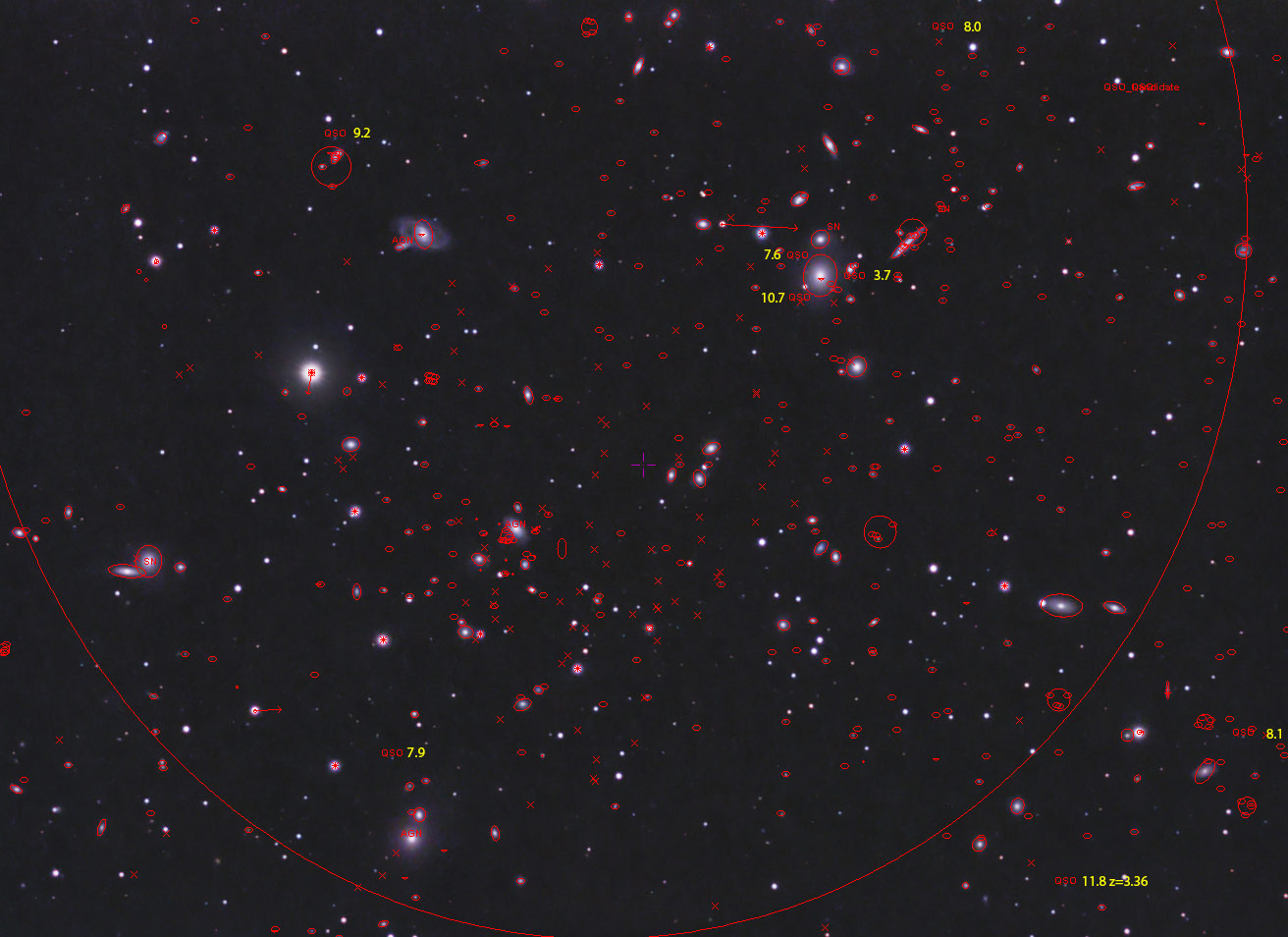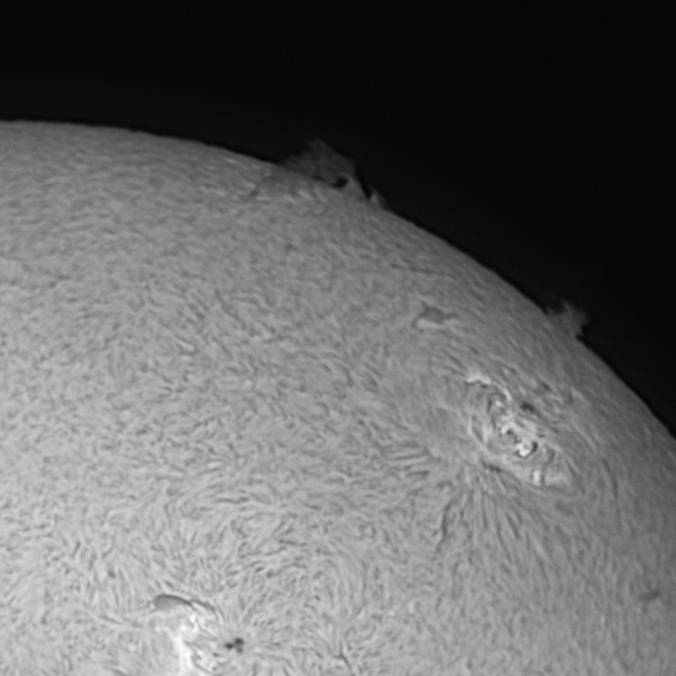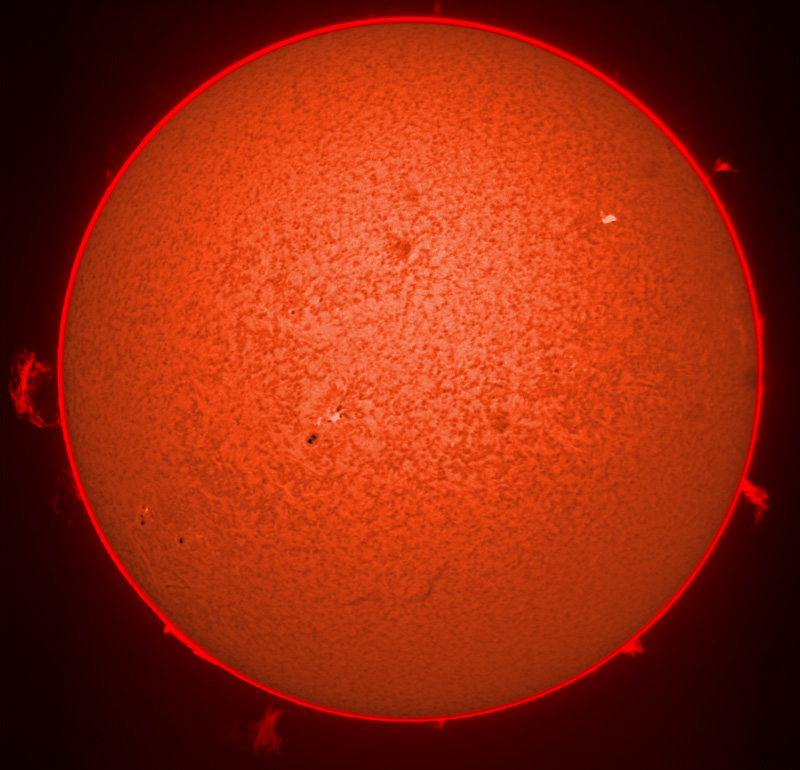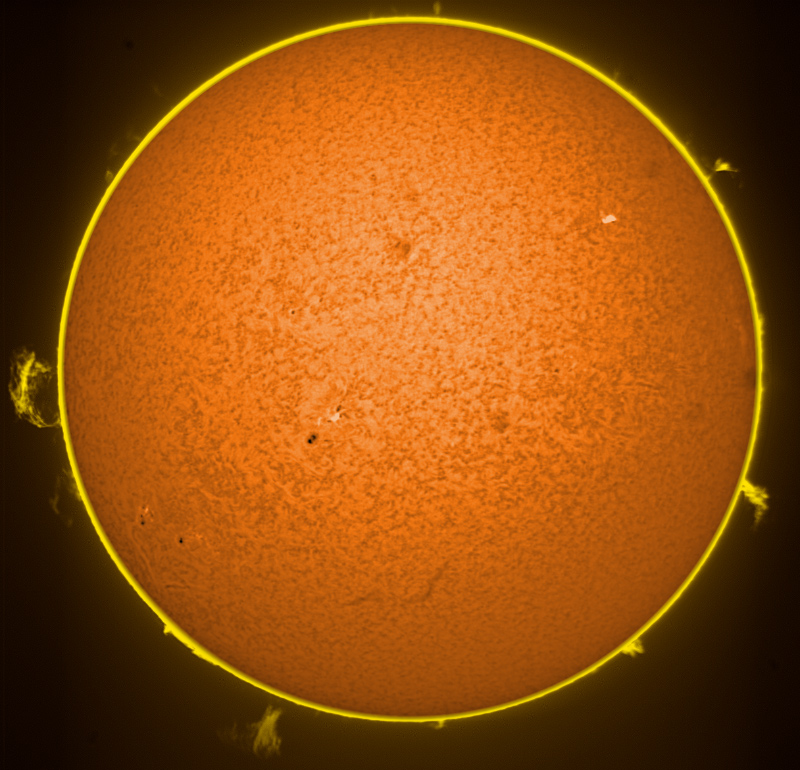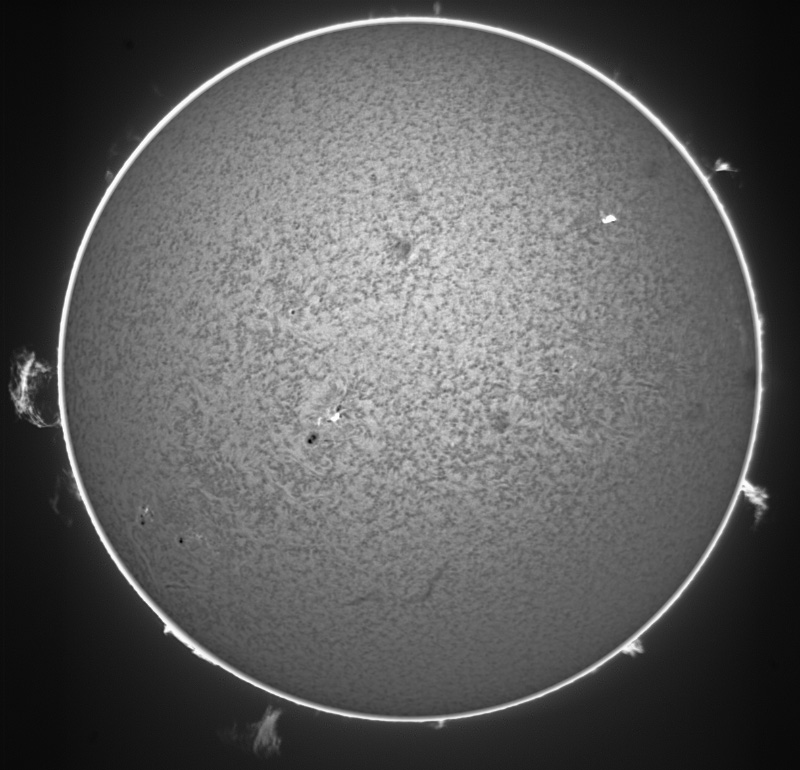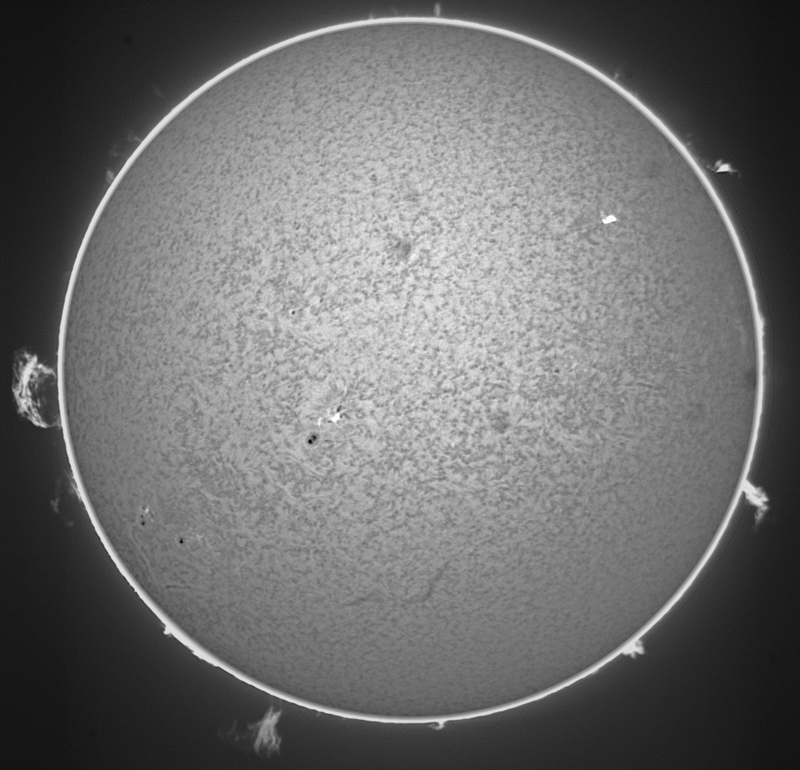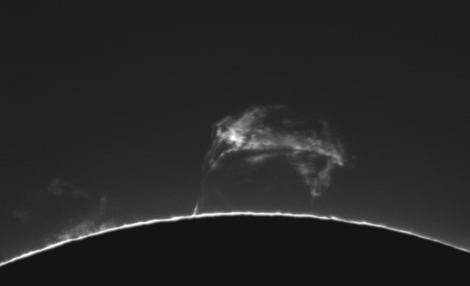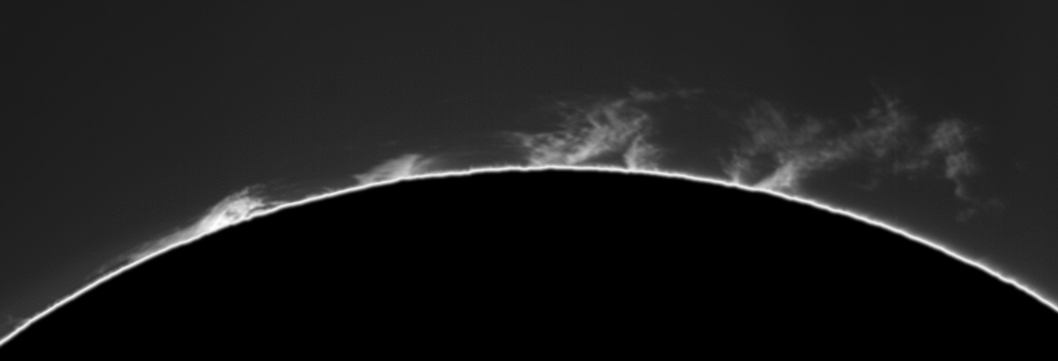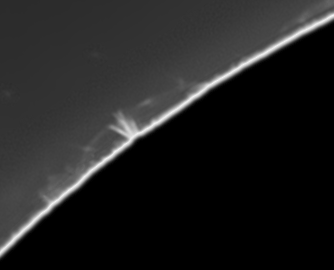when distances get very large, astronomers measure the "red shift"
of light to determine distances:
more distant objects are moving away more rapidly due to the
expansion of the universe
and therefore the light from these objects is shifted further to
longer wavelengths (more red) by the Doppler effect*
this was part of Hubble's big thing,
took two very cool discoveries:
1 certain fuzzy patches had shockingly large redshifts suggesting they are
"island universes" (galaxies) much further away than we had imagined.
2 a special type of variable star has a period proportional to it's
absolute brightness, which means they can be used to measure
distances with reasonable accuracy by comparing the measured brightness to the absolute brightness.
Hubble combined these discoveries, plotting distance to galaxies versus red shift
and found more distant galaxies were moving away more rapidly
proving the expansion of the universe
Abell 1367 has a redshift of 2.2%
this means that hydrogen alpha emissions at 656 nm will be shifted to 700 nm
completely out of the range of my narrow band Ha filter (5 nm centered at 656)
fortunately, i have an SII filter centered at 672 nm with a 12nm band width
allowing me to catch redshifted hydrogen emissions with a filter designed for sulfur
which is a cool trick, part of why i picked the cluster
though subtle, i caught one galaxy that definitely shows enhanced Ha emissions:
The upper right tail of this edge-on spiral galaxy (UGC 6697) is clearly blue
(due to active young star formation) in standard images
but has a red patch in the middle of the blue with the SII (Ha)
enhanced images
and possibly a more subtle red area around the bright core
due to hydrogen emissions in a large nebula (often found in star
forming regions)
or active galactic nucleus = black hole feasting on stars emitting high energy photons as it rips apart matter
there were two much more subtle regions
the upper arm of the small spiral galaxy NGC 3861b:
and the red smile in this faint irregular galaxy KUG 1140+202A:
:-)
*technically not the Doppler effect in this context
Try increasing gamma if dark sections aren't distinguished
Saturday, August 16, 2014
Wednesday, August 13, 2014
Leo Galaxy Cluster aka Abell 1367: Part 1 Deep Sky
factoid: Abell 1367 has more galaxies brighter than mag 14 than any other galaxy cluster
the term "deep sky objects" is used by amateur astronomers to denote
objects other than solar system objects and individual stars.
as some may have notice, all of my images since moving have involved objects in our solar system,
most sol itself. the most distant object being saturn at approximately 8 million miles or 11 a.u. or 1 light hour
at 330 million light years, Abell 1367 goes to the other extreme.
to put things in perspective, the closest star is 4 light years away
the pleiades are 375 light years (ly) away
orion nebula 1500 ly
crab nebula 6000 ly
the black hole at the center of the milky way 27,000 ly
the andromeda galaxy 2 million ly
M51, the whirl pool galaxy 15 million ly
the virgo galaxy cluster 50 million ly
most of the dots in this field are not stars, but galaxies each containing billions of stars.
here's an annotated version with galaxies circled
the large circle outlines the galaxy cluster itself which is a bit bigger than my field of view
objects circled with an arrow pointing away are high proper motion stars
more about QSO's later
the term "deep sky objects" is used by amateur astronomers to denote
objects other than solar system objects and individual stars.
as some may have notice, all of my images since moving have involved objects in our solar system,
most sol itself. the most distant object being saturn at approximately 8 million miles or 11 a.u. or 1 light hour
at 330 million light years, Abell 1367 goes to the other extreme.
to put things in perspective, the closest star is 4 light years away
the pleiades are 375 light years (ly) away
orion nebula 1500 ly
crab nebula 6000 ly
the black hole at the center of the milky way 27,000 ly
the andromeda galaxy 2 million ly
M51, the whirl pool galaxy 15 million ly
the virgo galaxy cluster 50 million ly
link to full size
most of the dots in this field are not stars, but galaxies each containing billions of stars.
here's an annotated version with galaxies circled
the large circle outlines the galaxy cluster itself which is a bit bigger than my field of view
objects circled with an arrow pointing away are high proper motion stars
more about QSO's later
link to full size annotated
details:
FS102 OLV @ 618.8 mm, 2.15”/px, IDAS LPR filter/astronomiks 12nm SII filter, SX H9/H9C camera
Luminance 120x5 min, RGB 25x20 min, SII 24x20 min
4/24-5/5/2014 Newport Beach, CA
needless to say it took a lot of work to pull the galaxies out of the light pollution in the image
Luminance 120x5 min, RGB 25x20 min, SII 24x20 min
4/24-5/5/2014 Newport Beach, CA
needless to say it took a lot of work to pull the galaxies out of the light pollution in the image
Saturday, July 26, 2014
filaprom
a solar prominence is typically a structure seen on the edge of the sun against the black background of space. it often looks like an arch. it consists of hydrogen plasma held off of the surface by magnetic fields.
a solar filament is a large dark line seen across the face of the sun. again hydrogen plasma held off the surface, but over the surface facing the observer, rather than on edge.
in a sense, they are two sides of the same coin:
the filament absorbs the intense light from directly beneath then re-radiates it in all directions, with only a small amount heading directly on a line to the observer. This is why filaments appear dark on the solar disk. On the edge, we see the weaker emission component of the filament against a dark background.
that being said, i had difficulty visualizing filaments as the same structure.
this is in part due to the fact that most images which show prominences are processed in order to lighten them compared to the surface to show more detail, so prominences always seem lighter.
...until i caught a filaprom. a filament that continues off the edge of the solar disk, clearly showing a dark line arching up over the surface:
2/16/14 newport beach, ca
DMK 51, 2.5x Powermate, Lunt 60 PT B1200
*manually guided on an altazmuth takahashi teegul mount.
took quite some time to process as software would not track well on solar image moving all over the field
a solar filament is a large dark line seen across the face of the sun. again hydrogen plasma held off the surface, but over the surface facing the observer, rather than on edge.
in a sense, they are two sides of the same coin:
the filament absorbs the intense light from directly beneath then re-radiates it in all directions, with only a small amount heading directly on a line to the observer. This is why filaments appear dark on the solar disk. On the edge, we see the weaker emission component of the filament against a dark background.
that being said, i had difficulty visualizing filaments as the same structure.
this is in part due to the fact that most images which show prominences are processed in order to lighten them compared to the surface to show more detail, so prominences always seem lighter.
...until i caught a filaprom. a filament that continues off the edge of the solar disk, clearly showing a dark line arching up over the surface:
2/16/14 newport beach, ca
DMK 51, 2.5x Powermate, Lunt 60 PT B1200
*manually guided on an altazmuth takahashi teegul mount.
took quite some time to process as software would not track well on solar image moving all over the field
Sunday, July 13, 2014
lost disk in color
what color are the Ha (hydrogen alpha) images of the sun?
hydrogen alpha is red, but viewing thru my solar scope, it looks reddish orange to me
no idea why, the filter is clearly red.
the images below are composites, combining a short exposure which picks up the bright surface detail
with a longer exposure burning out the center in order to pick up the faint prominences projecting off the edge of the disk.
when combining these the prominences typically appear brighter than the disk, an artifact of processing in an attempt to bring out the faint detail in the prominence
in the first colorized version below, i used orange for the central structure and pure red for the prominences
in an attempt to correct for this brightening:
seemed like a good idea, but a bit of the detail in the prominences is lost
here's a more aesthetically pleasing version with yellow flames shooting off the surface:
Friday, July 4, 2014
4th of july fireworks from the lost disk
back in may i took a quick look at the sun and saw multiple prominences erupting around the disk. one of which looked like it was lifting off, so i zoomed in on it and was lucky enough to catch a lift off (prior entry).
after processing the lift off images,
i looked at all the full disk images
and discovered all the images occurred after the lift off was complete, missing multiple prominences
found the original full disk image from the start of lift off
misfiled on my hard drive so here it is:
i also found one more frame for the start of the close up animation
here's a small version:color versions later
happy 4th
5/4/14 newport beach, ca
DMK 51, Lunt 60 PT B1200, ASA DDM60
images captured ~ every 5 mintues
images captured ~ every 5 mintues
Sunday, June 22, 2014
happy solstice
more solar work
first a prominence animation.
I've increased the imaging frequency and animation speed to give more fluid motion in this one.
here's the prominence image now that i've typed enough to avoid the annoying navigation bar to the upper right (animation link below)
Here's the animation (large file)
the animation is a total of 76 images taken every 2 minutes
starting 3:30 pm on 5/31/14
each image was constructed by stacking 300 frames
captured at 11 frames per second
here's a crop off the lower left side edge with rapid, small scale eruptions:
this is full scale with a rate 5 fps (half the prior image)
(top is 75%)
Here's a full disk animation which is...less dramatic
the interesting part is that you can see the sun's slow rotation
as the animation snaps back to the beginning:
full disk animation (large file)
here's a bit of activity upper left at full scale:
first a prominence animation.
I've increased the imaging frequency and animation speed to give more fluid motion in this one.
here's the prominence image now that i've typed enough to avoid the annoying navigation bar to the upper right (animation link below)
Here's the animation (large file)
the animation is a total of 76 images taken every 2 minutes
starting 3:30 pm on 5/31/14
each image was constructed by stacking 300 frames
captured at 11 frames per second
here's a crop off the lower left side edge with rapid, small scale eruptions:
this is full scale with a rate 5 fps (half the prior image)
(top is 75%)
Here's a full disk animation which is...less dramatic
the interesting part is that you can see the sun's slow rotation
as the animation snaps back to the beginning:
full disk animation (large file)
here's a bit of activity upper left at full scale:
boring details:
prominence:
5/31/14 newport beach, ca
prominence:
5/31/14 newport beach, ca
DMK 51, 2.5x Powermate, Lunt 60 PT B1200, ASA DDM60
76 images taken every 2 minutes
starting 3:30 pm on 5/31/14
each image was constructed by stacking 300 frames
captured at 11 frames per second
full disk:
76 images taken every 2 minutes
starting 3:30 pm on 5/31/14
each image was constructed by stacking 300 frames
captured at 11 frames per second
full disk:
5/4/14 newport beach, ca
DMK 51, Lunt 60 PT B1200, ASA DDM60
images captured ~ every 5 mintues
images captured ~ every 5 mintues
Thursday, June 5, 2014
Saturn and friends
caught saturn the other night with fair seeing
a number of moons were evident visually
visually i was able to see titan, tethys, reha and dione
stretching in photoshop brought out enceladus and surprisingly, faint hyperion up top.
mimas is lost in the glare just below the planet and iapetus is way off the field to the left
Details
6/1/2014 costal peak park, newport beach, ca
Nexstar 8 GPS, ZWO ASI120MC camera
for disc close up
Shutter=9.560ms Gain=97 Gamma=50 104 fps
moons
Shutter=29.53ms Gain=97 Gamma=88
FPS (avg.)=13
Subscribe to:
Posts (Atom)



